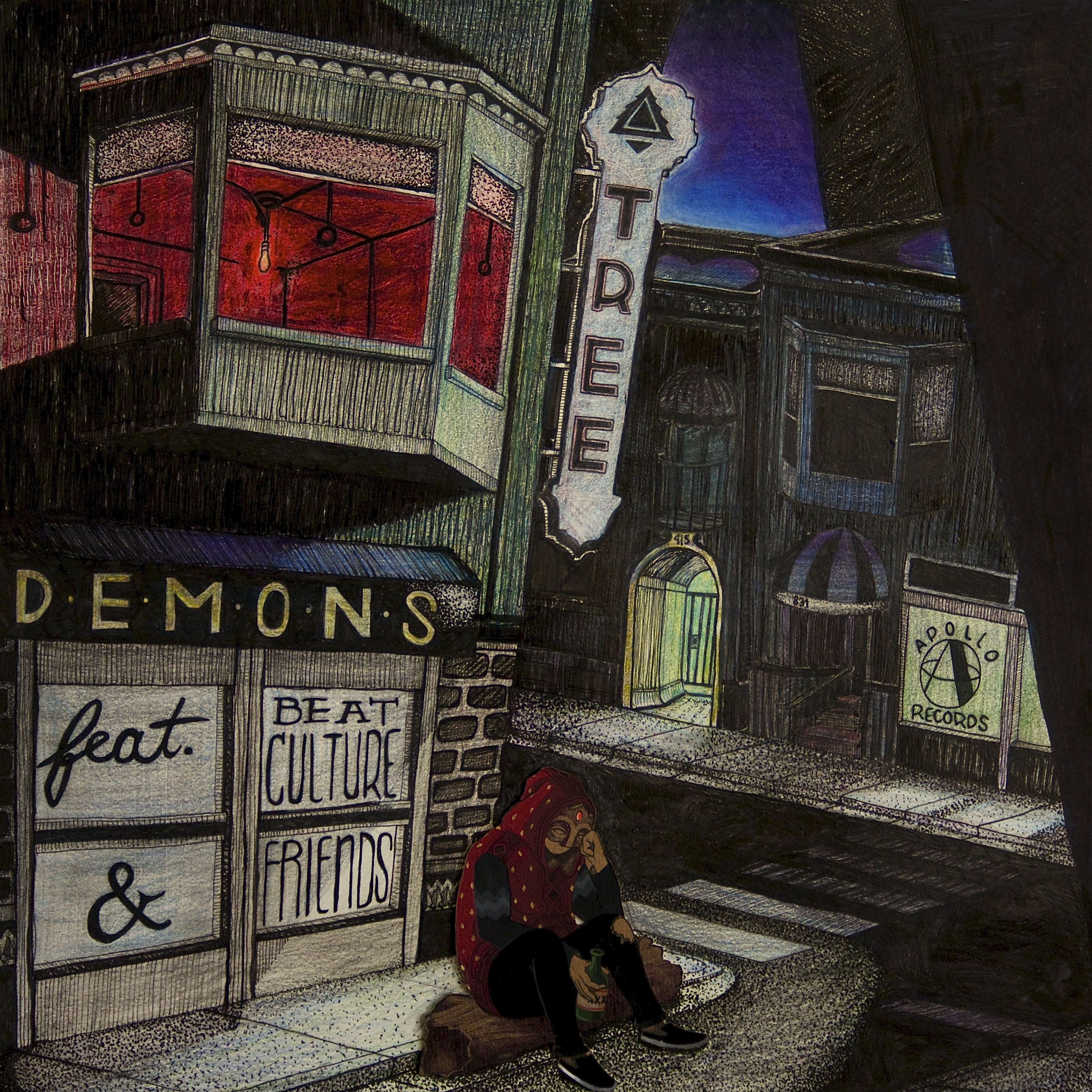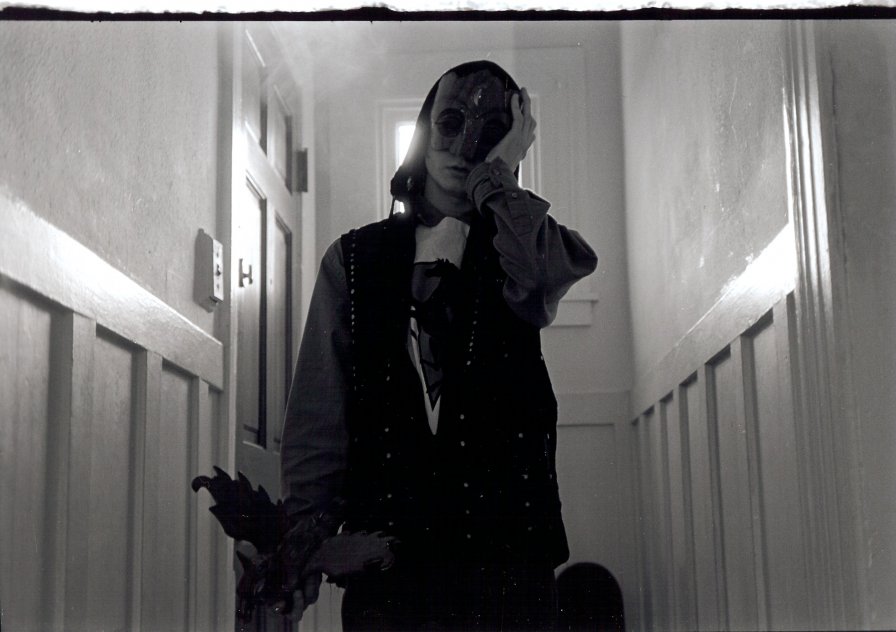What was the inspiration for “Demons” lyrically? Is it about your drug use?
Yeah, it’s a mixture of that and of leaving Santa Cruz for San Francisco. It was just a whole new time for me. I don’t know, living in a city can be a dark, gloomy thing — especially San Francisco. I mean, it’s not hard to get depressed there; not that I was heavily depressed, but everyone goes through their dark periods.
Did moving to the city at least open things up for you artistically, as far as meeting other artists and that kind of thing?
Yeah, I started Tree Collaborations with Drew Grasso — one of my old middle school bandmates — when I was in San Francisco. He moved up to the city too, and he became the lead artist for Tree Collaborations. He went to San Francisco Art Institute, and he basically hand-picked the whole team of artists that we would work with. His roommate ended up being Steve Dabal, the guy who made the music video for “Karma Police” with me, and who made the video for “Tully” off of Splitting Branches. Have you seen that video?
if I had continued, I feel like it could have been a full-time gig. I was signed to an agency that was throwing big parties, and I was the opener for them. I played this massive gig in San Francisco with Skrillex, Datsik, and Nero — some of the biggest dubstep artists at that time. It was a mind-blowing experience for me; it was like being a little rock star for a day.
Yeah, I like that one.
Thank you. We were all freshly 18 and just moved up to the city, and we decided to make a music video. So we got four or five people together, and it took a year-and-a-half to make that two-minute video. We were making all kinds of other stuff at the same time — at certain moments, things fall back and you have to let go of them for a bit, and then you come back to them later. I don’t know — we have a pretty strange way of working on things. At least we finished it; that’s the main thing.
There are a lot of precise details in that video. I’m not surprised it took a while to get right.
Yeah, and a lot of it was because we basically hand-animated it. They printed out each frame, and Drew would put that printout onto a light board and trace out a worm on top of it. And then he’d take a picture of what he drew and send it to Steve, who was editing the video, and he’d have to cut it out and glue it into the frame. It was the most ridiculous process — it was just insane. Drew could have just drawn on top of the frame if we used something called a tablet (which he later figured out for the “Demons” video), but we had no idea, basically — we didn’t know the technology yet. It was all part of the learning process. But the reason it took so long was that Drew animated it so many times, just trying to figure out how to do it with this old-school technique.
Going back to Demons, tell me about the second track, “Karma Police.” When did you decide to include a cover?
Well, it was actually Renaat’s idea to do a cover. I had already made “Stuck Down the Wrong Rabbit Hole,” “Demons” was in the process, and he suggested we try a cover for the third track. I like covering songs because every time I do it I learn all the techniques the original artist used to make that song — you know? You learn so much every time you remake someone else’s song. So I decided to find a song to cover that was in my range. I thought of maybe a handful of artists, and Radiohead just happened to be one of them. I was playing various songs and trying to sing along, and when I got to “Karma Police” I thought: “This shoe might match; there might be a fit here.”
And you did some of the recording in London and worked with a string quartet, right?
Yeah, I did part of it in London. I started out recording it in San Francisco and Santa Cruz, and then I was very fortunate and blessed that my label brought me to London to finish the recording and work with a crew there. I had already recorded a lot of the song — like the cello, the vocals, and some of the marimba bits — and then we took it into the studio and essentially reworked it into something completely different. It was an incredible experience. But the string quartet actually didn’t happen when I was in London. I was mostly just working in the studio, and then afterwards we had the string quartet come in; that was a later idea.
Was it a smooth process getting permission from Radiohead?
So much energy had already been invested in it, so emotionally it was a bit distressing. But it turned out to be a breeze — they got back to us within a week, essentially.
How has the response been? I imagine it’s tricky covering such a popular song.
The response has been very, very diverse. I’ve read reviews where people have torn it to pieces, and I’ve read reviews where people say it’s better than the original. I don’t take any of them personally; I know it’s very subjective for each person, and where they’re at in their life. I find humor in the inconsistency, without a doubt. But personally, I’ve been quite happy with it, just on SoundCloud plays alone — seeing that people are listening to it. That’s made my year worth it already, you know?
Once we got to high school we got really into drugs, which is one of the downsides of living in Santa Cruz; there are a lot of quality drugs coming in and out, and there’s pretty easy access for kids.
We’ve already touched on it a bit, but what about the final track on Demons, “Stuck Down the Wrong Rabbit Hole?” You recorded that one first and it came out pretty quickly?
I posted it not knowing what to expect, and I got a tremendous response — labels started hitting me up, MTV hit me up. I didn’t imagine anything like that was going to happen.
So, tell me more about Tree Collaborations. You’re working with visual artists, you’re working with film directors, you have T-shirts for sale on your website — what’s the vision behind this bigger project?
Tree Collaborations is a large effort between so many different hands. To make Demons alone — between my label, my publishers, PR people, radio pluggers, collaborating musicians, the animation crew, all the artists who were part of making the videos and cover art, plus the designer of the vinyl, photographers, copy writers and everything like that — it took something like 40 people. It’s a massive effort just to make something as small as a three-song release. It’s almost similar to a band — but a band of artists and musicians alike who are not confined to one specific genre. I think we’re people who want to create and leave a trail behind us. I just want to make stuff until I die, and I want to have as many people help me do it as possible. I’m kind of leading the way right now, but there are so many other people that it would be impossible without.
It’s also kind of like the Gorillaz, where there’s a whole visual element — a character that we’re starting to evolve, basically. We’re creating a world for this guy to live in, and a whole backstory for him. It gives us a lot of opportunities for storytelling, and to do different things with it. A big part of creating the character with the mask… Well, have you noticed the guy in the mask who is on the covers?
Yeah.
So, he’s the character behind it, and for me he is the persona and the face of Tree Collaborations. It kind of removes me from the center of it, and puts this character in the forefront. But it’s slowly developing, and it’s always going to be changing. It’s very tricky — there are always a lot of different things that can go wrong. But hopefully I’ll be making movies with it someday, like a full-length feature film in the next 10 or 20 years. Hopefully it will be something that can travel around the world, putting on shows that will be a full audio/visual experience — that will let people disappear for a few hours, you know?
Speaking of, what are Tree live shows like? Are you playing out at all right now?
No, zero live shows. Right now I’m building a stage, and I just got a projector, so I’m collecting visuals. But it doesn’t make sense to tour without an album, so I’m focused on making an album; I’ve just started working on it.

And who does the bulk of the visual art for Tree Collaborations?
Grasso and Zane Prater are the main two. They did the Demons cover art together — they’ve done pretty much all the cover art.
I like their work. I’ve been to Prater’s website — it seems like it hasn’t been updated in a while, but there’s some great stuff on there.
Yeah, last I heard he was going to be putting together a completely new gallery show, so I’m not surprised he’s not sharing work. Lately I’ve been working with a new guy named Mikey Joyce, too. He’s talented, and he’s helping me out with some new stuff.
You mentioned in an email that you’re working on building up the electronic scene in Santa Cruz right now — is there anyone I should look out for?
Yeah, totally: my friend Mist Glider, my friend Aeropsia…
He collaborated with you on “From Reds to Blues,” right?
Yes, him. Also Shelf Nunny, this guy named Heart-Tricks, a guy named JORD∆N, Lena Kuhn… They’re all local people who make incredible music. For me, it’s awesome to be back in Santa Cruz surrounded by so many artists. It’s inspiring on so many levels, and it makes me want to work on building up the community. Mist Glider and Aeropsia started this label called Sleepy Beach, which is a platform to give away free music by local Santa Cruz people.
That’s cool — I’ll check it out.
Yeah, it’s an awesome thing they’re doing. It’s cool because I hang out with my friends, and sometimes we’ll all be in a room making our own music with headphones on, and we’re all making music that sounds completely different. We use the same exact program — Ableton — but everyone has their own technique. With Ableton you can do the same thing 10 different ways, almost. And it’s cool because we teach each other stuff, but everyone is staying true to their own style; there’s never been a problem with people making songs that sound like each other’s stuff. Everyone’s just letting it evolve.
And how’s the work on your album going? What is it going to be like?
You’re not going to really know what to expect. I’m still in the middle of creating it, but “Stuck Down the Wrong Rabbit Hole” and “Demons” will both be on there. It will have elements of stuff like that, but I think it’s going to be pretty different. I want it to cover a lot of different styles and go in a lot of different directions. So I’m just working on merging genres right now — I would love to keep experimenting and bending various styles together.
